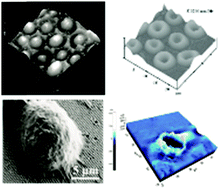当前位置:
X-MOL 学术
›
Chem. Soc. Rev.
›
论文详情
Our official English website, www.x-mol.net, welcomes your
feedback! (Note: you will need to create a separate account there.)
Cancer bioimprinting and cell shape recognition for diagnosis and targeted treatment
Chemical Society Reviews ( IF 40.4 ) Pub Date : 2017-06-29 00:00:00 , DOI: 10.1039/c7cs00179g Jevan Medlock 1, 2, 3, 4 , Anupam A. K. Das 1, 2, 3, 4 , Leigh A. Madden 2, 3, 4, 5 , David J. Allsup 2, 3, 4, 6 , Vesselin N. Paunov 1, 2, 3, 4
Chemical Society Reviews ( IF 40.4 ) Pub Date : 2017-06-29 00:00:00 , DOI: 10.1039/c7cs00179g Jevan Medlock 1, 2, 3, 4 , Anupam A. K. Das 1, 2, 3, 4 , Leigh A. Madden 2, 3, 4, 5 , David J. Allsup 2, 3, 4, 6 , Vesselin N. Paunov 1, 2, 3, 4
Affiliation

|
Cancer incidence and mortality have both increased in the last decade and are predicted to continue to rise. Diagnosis and treatment of cancers are often hampered by the inability to specifically target neoplastic cells. Bioimprinting is a promising new approach to overcome shortfalls in cancer targeting. Highly specific recognition cavities can be made into polymer matrices to mimic lock-and-key actions seen in in vivo biological systems. Early studies concentrated on molecules and were inhibited by template size complexity. Surface imprinting allows the capture of increasingly complex motifs from polypeptides to single cell organisms and mammalian cells. Highly specific cell shape recognition can also be achieved by cell interaction with imprints that can be made into polymer matrices to mimic biological systems at a molecular level. Bioimprinting has also been used to achieve nanometre scale resolution imaging of cancer cells. Studies of bioimprint-based drug delivery on cancer cells have been recently trialled in vitro and show that this approach can potentially improve existing chemotherapeutic approaches. This review focuses on the possible applications of bioimprinting with particular regards to cancer understanding, diagnosis and therapy. Cell imprints, incorporated into biosensors can allow the limits of detection to be improved or negate the need for extensive patient sample processing. Similar cell imprinting platforms can be used for nanoscale imaging of cancer morphology, as well as to investigate topographical signalling of cancer cells in vitro. Lastly, bioimprints also have applications as selective drug delivery vehicles to tumours with the potential to decrease chemotherapy-related side effects.
中文翻译:

癌症生物印迹和细胞形状识别,用于诊断和靶向治疗
在过去的十年中,癌症的发病率和死亡率都在增加,并且预计将继续上升。癌症的诊断和治疗通常因无法特异性靶向肿瘤细胞而受到阻碍。生物印迹是克服癌症靶向不足的一种有前途的新方法。可以将高度特异性的识别腔制成聚合物基质,以模仿体内看到的锁键动作生物系统。早期研究集中在分子上,并受模板大小复杂性的抑制。表面印迹可以捕获越来越复杂的基序,从多肽到单细胞生物和哺乳动物细胞。高度特异性的细胞形状识别也可以通过细胞与印记的相互作用来实现,这些印记可以制成聚合物基质,从而在分子水平上模拟生物系统。生物烙印也已用于实现癌细胞的纳米级分辨率成像。最近在体外进行了基于生物印迹的药物在癌细胞上的研究并表明该方法可以潜在地改善现有的化学治疗方法。这篇综述着重于生物印迹的可能应用,特别是在癌症的理解,诊断和治疗方面。整合到生物传感器中的细胞印迹可以改善检测范围,或者无需进行大量的患者样品处理。相似的细胞印迹平台可用于癌症形态的纳米级成像,以及在体外研究癌细胞的地形信号。最后,生物烙印还可以作为选择性药物传递载体应用于肿瘤,具有减少与化疗相关的副作用的潜力。
更新日期:2017-06-29
中文翻译:

癌症生物印迹和细胞形状识别,用于诊断和靶向治疗
在过去的十年中,癌症的发病率和死亡率都在增加,并且预计将继续上升。癌症的诊断和治疗通常因无法特异性靶向肿瘤细胞而受到阻碍。生物印迹是克服癌症靶向不足的一种有前途的新方法。可以将高度特异性的识别腔制成聚合物基质,以模仿体内看到的锁键动作生物系统。早期研究集中在分子上,并受模板大小复杂性的抑制。表面印迹可以捕获越来越复杂的基序,从多肽到单细胞生物和哺乳动物细胞。高度特异性的细胞形状识别也可以通过细胞与印记的相互作用来实现,这些印记可以制成聚合物基质,从而在分子水平上模拟生物系统。生物烙印也已用于实现癌细胞的纳米级分辨率成像。最近在体外进行了基于生物印迹的药物在癌细胞上的研究并表明该方法可以潜在地改善现有的化学治疗方法。这篇综述着重于生物印迹的可能应用,特别是在癌症的理解,诊断和治疗方面。整合到生物传感器中的细胞印迹可以改善检测范围,或者无需进行大量的患者样品处理。相似的细胞印迹平台可用于癌症形态的纳米级成像,以及在体外研究癌细胞的地形信号。最后,生物烙印还可以作为选择性药物传递载体应用于肿瘤,具有减少与化疗相关的副作用的潜力。











































 京公网安备 11010802027423号
京公网安备 11010802027423号